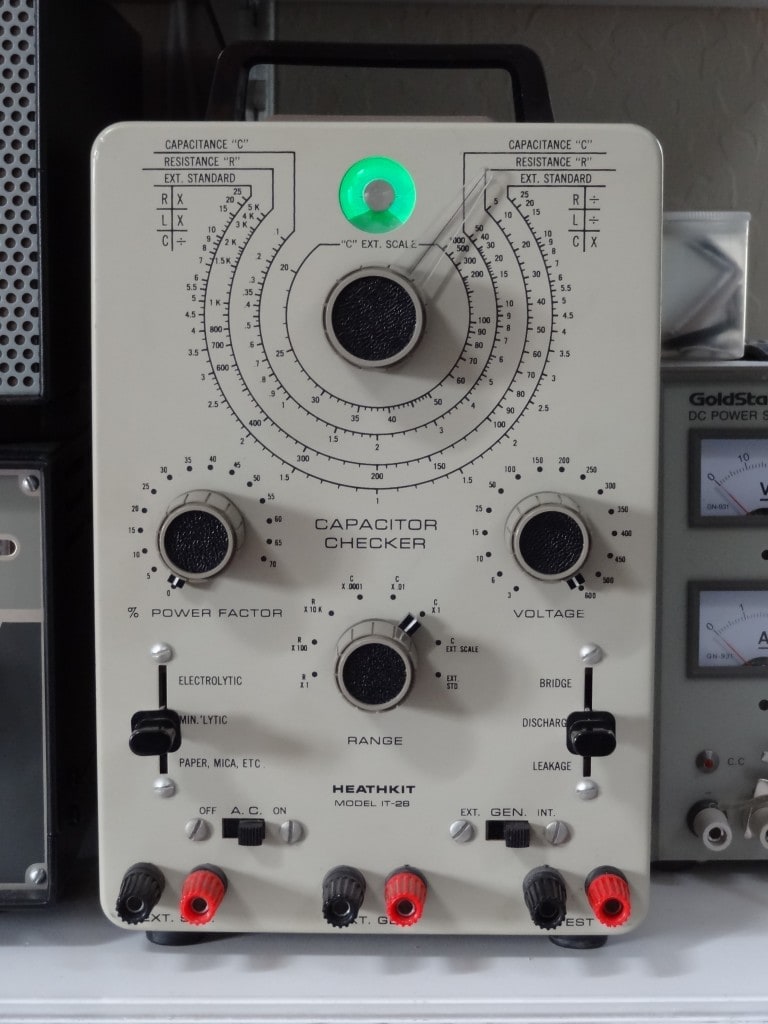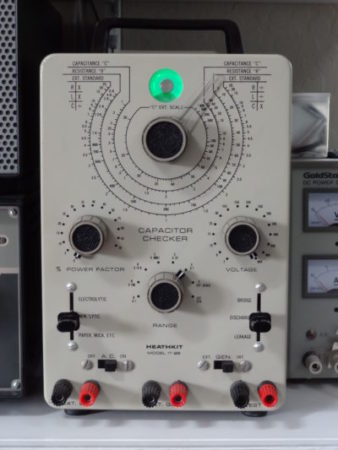by Thomas Bonomo, K6AD —

Sure, I know what you’re probably thinking. The trouble-free nature and accuracy of modern test equipment is just too tempting to ignore. Usually, I’d be nodding my head with you. I’m generally not a fan of vintage test equipment—tube test equipment in particular. There’s nothing more frustrating than getting all set up to work on a radio, only to be forced to stop your nailing to work on the hammer. But this is one piece of test equipment that is fairly reliable, and whose most useful functions are not easily duplicated at the low prices these testers usually command.
Like many modern digital meters, this vintage capacitor checker can measure capacitance, resistance and inductance. In truth, however, I rarely use these measurement functions. They’re handy, to be sure, and the accuracy is usually good enough for most broadcast radio applications. Only if I am running one of the tests discussed below do I bother to let the eye tube tell me if a capacitor’s value is “in the ballpark.”
The secret to this tester’s usefulness lies in its ability to measure capacitor leakage under working voltages from +3 to +600 volts. Countless times I’ve wondered if a capacitor I’m about to replace is responsible for the faulty performance of a certain radio stage. It’s sort of a curiosity thing with me. The IT-28’s green eye tube can easily show if a capacitor is leaky. The unit provides standardized leakages tests from a front panel switch marked “Electrolytics”, “Miniature Electrolytics”, and “Paper, Mylar, Etc.” Even if I intend to replace an old paper capacitor with a modern Mylar, running a leakage test on the old cap at its working voltage satisfies my curious nature. You can’t do leakage tests at working voltage with most digital testers–not unless you buy a much fancier one than is commonly available. And you’ve got to admit, the glowing green eye tube is just cool to use. Something utterly magical about it.
A second great use of this tester is to season electrolytic capacitors. Many NOS modern electrolytics have been sitting on the shelf for years since they were manufactured. Put one in a radio and then hit it with full working voltage, and you sometimes get the sound and smell of an instant barbeque—one you’d rather avoid. You can use the IT-28 to easily bring an electrolytic up to its full working voltage in incremental steps, all the while monitoring the eye tube for leakage. I do this with every new electrolytic I replace. Some of the new electrolytics in my parts inventory have sat, unused, for a decade or more. Who knows how long they sat on a distributor’s shelf before that. The IT-28 will save you from all those unnecessary radio fireworks.
A word about Heathkit equipment. Based on my experience, I’d say 90% of these kits have at least one bad solder joint or wiring error. No surprise then, that you often see dysfunctional performance. The IT-28 you see in the photo had no less than 7 bad solder joints on the voltage and range rotary switches. The guy who built this unit failed to see that he was only using enough solder to properly attach the top lead. The leads underneath often had no solder on them whatsoever. The result was erratic performance, and many “dead” positions on the function switches. So if you purchase one of these, open it up and examine every solder joint. The good news is that the IT-28 uses straightforward circuitry, is easy to work on, and is simple to calibrate. All you’ll need is a manual, which is easy to find online. When conducting tests, especially if you use alligator test leads, don’t forget that there is up to 600 VDC applied to the part under test. Forget, and you’ll find yourself suddenly much more “alert to your environment.”
Heathkit introduced an earlier version of this tester in 1961 as the IT-11. Minor changes were made in 1968, and the updated model became the IT-28. The IT-28 was available until 1977—a 16 year life for the line. The IT-28 featured Heathkit’s tan color scheme, a grounded three-wire power cord, a spring-clamp on the 6AX4 rectifier tube socket, and a power transformer that could be wired for 240 volts. Unlike the earlier IT-11, which used adjustable set-screw knobs, the IT-28 used less desirable push-on knobs that can’t be easily re-adjusted.
There are plenty of similar testers on the market. Knight, EICO, and Lafayette manufactured units with comparable functionality. The EICO 950B is very popular, often seen at swapmeets, and it uses the less expensive 1829 eye tube. There is a good YouTube video showing the many uses of this type of tester at http://www.youtube.com/watch?v=G2yo0AVm9tY
If you spot one any of these testers at a swapmeet, by all means grab it, fix it, and use it! Happy testing.



Tom, great article. Excellent photo. Keep these coming!
Nice article. Nice to see these old pieces of test gear still being used. I must point out, that the eye tube is a 1629, not an 1829. Of course as usual, all old tube gear should be re-capped for any kind of reliability. That includes this IT-28 or IT-11.
Great article! I thoroughly enjoyed the personal comments based on restoration experience, good job. Do you do tube testers? I’d like to see some restoration hints on them, very interested in that. Radio on!! Rich
Hi Rich, I haven’t had to work on many tube testers, aside from having to replace the occasional worn out socket. I guess I’ve been lucky that my Hickok 539C and B&K 707 have treated me fairly well so far.
Just bought one of these on Ebay, smells like an ash tray and inside filthy. From the replacement tubes my guess is it has seen a lot of use. I am going to replace the caps and put on my workbench so it will be ready the next time I need it.
Quite interesting and useful advice. Saved to my bookmarks .
Appreciate the amazing read.
The earlier edition of this tester is the IT-11. The ’28 got a face lift, better knobs, and a three wire power cord. Otherwise they are identical instruments. I just restored an ’11 for the shop. Recapped and calibrated, I was surprised how well it registers capacitor leakage, having depended for years on my trusty TO-4. One of Heath’s best thought out instruments, IMO.
I bought a handful of those “top hat” knobs, used on the IT-28 Lever Switches, for 25c each at a music store in Santa Clara. These are the same knobs used on the pickup selector switch on Fender Telecaster guitars. They’re very common and available wherever electric guitar parts are sold. Apparently they fall off after a while!